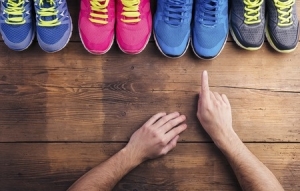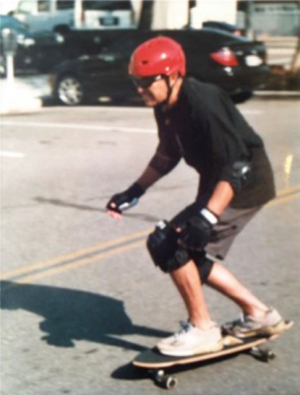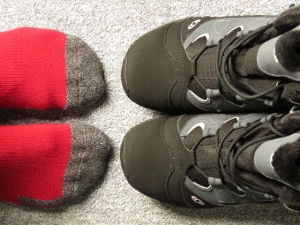Connect With Us
Blogs
Displaying items by tag: athlete's foot
How to Select the Proper Shoe for Running and Walking
When it comes to running or walking for exercise, we at Superior Foot & Ankle Center believe that the most important piece of equipment required is a good shoe that is properly fitted for your individual foot. You do not need different shoes for running and walking. Running shoes usually have more shock absorption and are fine for walking.
Below are some tips to help you choose the right shoe and get a good fit:
- Start with an appointment with one of our podiatrists, Dr. Victoria Foley or Dr. Constance Ornelas. The right shoe for you will depend on your foot type. If you have a high arch or you wear a custom orthotic device, a cushioned neutral shoe is best. For someone with flat feet, a stability shoe is recommended. See our approved shoe list for specific brands and styles. Your foot doctor can make suggestions for particular styles or features if you have a toe deformity or other foot or ankle condition that will help protect the area and make running or walking more comfortable.
- Get professionally fitted by a sports shoe expert. Most people have two different size feet. It’s essential to buy shoes to accommodate the larger foot. There should be a half-inch of space between your longest toe and the front of your shoe. A majority of people wear shoes that are too small for their feet and this leads to injury and deformity.
- Wear the socks you will run or walk in when you go to try on shoes. We recommend a cotton blend or a sock with CoolMax. Bleach white socks to prevent athlete’s foot.
- To avoid blisters, be sure that the heel of the shoe fits snugly and that the foot doesn’t slip when you walk. Also, run your hand around the inside of the shoe to check for rough stitching or bumps that can cause friction and result in a blister.
- Take your time when trying on shoes. Walk around the store for several minutes. Many running shoe stores will have a treadmill so that you can try running in the shoes as well.
- Remember to replace running/walking shoes after approximately 400 miles. Even good shoes lose their supportiveness once they are worn out and wearing them can present an increased risk of injury.
If you have more questions about running or walking and your feet, contact our Long Beach office by calling us at 562-420-9800.
Don’t Let Diabetes Slow You Down
Meet Joe Plank: He’s 81 years old and loves to skateboard! A Long Beach resident, Joe works as a grief counselor at the VA, helps autistic children in the county of Orange and enjoys lots of activities with his daughter and her family. Joe also has diabetes. As a patient of Superior Foot & Ankle Care Center, we see Joe as living proof that diabetes doesn’t have to stop you from living a full and (very!) active life.
One of the best ways to help control your blood sugar is through exercise. In addition, many diabetic patients suffer from neuropathy and circulation issues. Exercise is an excellent way to keep the blood flowing. Before skateboarding, Joe was an enthusiastic surfer for more than 6 decades. Although the activities that you choose may change over time, it’s important to make exercise and fitness a lifelong habit. Our board certified foot and ankle surgeons, Dr. Victoria Foley and Dr. Constance Omelas can make recommendations of activities and footwear that would best suit your feet and ankles. Your podiatrist can also tell you other ways to help take care of your feet if have diabetes. A few items that should be on your daily foot care regimen checklist include:
- Wash feet with a mild soap and warm (not hot) water. Dry completely, especially between the toes (to help prevent athlete’s foot).
- Inspect your feet, toes and ankles for changes. Look for swelling, cuts, bruising, changes in color, shape or size, bumps, rashes or blisters. Report anything unusual to the foot doctor immediately.
- Apply a rich moisturizer to keep feet supple and prevent skin and heel cracks.
- Keep toenails cut straight across and not too short to prevent ingrown nails from developing.
If you want to learn more about diabetic care and how to maintain an active lifestyle with this disease, contact our Long Beach office. And, be sure to wave to Joe if you see him skate boarding at Huntington Beach Pier. Remember, as Joe says, “Being a geezer is a conscious choice.”
What Causes Athlete’s Foot?
You may be familiar with the symptoms of athlete’s foot, especially if you’ve had it before: extremely itchy, burning skin (usually starting between your toes) that becomes red and flaky. If not treated, painful blisters may develop and athlete’s foot can spread to the rest of your foot, your toenails and even other parts of your body. At Superior Foot & Ankle Care Center we believe that prevention is the best treatment. Some common ways that athlete’s foot is spread include:
- Sharing socks, shoes, towels or anything that touches another person’s feet
- Walking barefoot in public places like gym locker rooms, public showers
- Poor hygiene: feet should be washed with soap and water every day and dried completely
- Choosing footwear not made of breathable materials that do not allow air to circulate
- Allowing feet to stay in damp socks and shoes—the perfect setting for fungi and bacteria to thrive
If you have symptoms of athlete’s foot, you should contact our Long Beach office for an appointment by calling: 562-420-9800. Our podiatrists, Dr. Victoria Foley and Dr. Constance Omelas will examine your feet to determine the best treatment. There are several different types of fungi that can cause athlete’s foot and it’s important to identify the fungus behind the infection in order to choose the correct type of medicine for treatment. Topical medications in the form of creams and sprays are often used to eliminate athlete’s foot. Oral medications may also be prescribed in more severe cases. The doctor may also suggest that you use an over the counter antifungal powder on your feet as a preventive measure going forward. For some patients, athlete’s foot may be a recurring problem.



